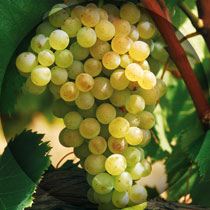Antão - Vaz (PT)
Variety: red | Category II | Portugal


General Information
Antão - Vaz


Origin: In the 1960s and 1970s, Colaço do Rosário (2005) was unable to find any older vineyards of this variety beyond the Vidigueira viticultural region. Given its geographical limitation, it has also been difficult to find any reference to this variety prior to the Phylloxera outbreak. It was labelled as variety number 84 in the Évora ampelography (1890). Even in the 20th century almost no reference is made to this variety. It was only later, with modern fermentation technology, that it assumed great importance throughout the Alentejo.
Chief areas of distribution: Vidigueira.
Official synonym(s) (national and OIV): None.
Historic and regional synonyms: None.
Homonym(s): None.
Area under cultivation: 600 ha.
New plantings: 0.55%.
Trend: Upward in its region.
Varietal variability: Medium.
Availability of propagating material: RNSV polyclonal material, certified clone 50 JBP.
Molecular Profile (OIV)
Regional Classification
Morphology
Phenology
Vegetative Potential
Viticultural Parameters
Oenology
Variety Characteristics
| VVMD5 | VVMD7 | VVMD27 | VrZag62 | VrZag79 | VVS2 | ||||||
| Allele1 | Allele2 | Allele1 | Allele2 | Allele1 | Allele2 | Allele1 | Allele2 | Allele1 | Allele2 | Allele1 | Allele2 |
| 234 | 236 | 245 | 259 | 181 | 183 | 204 | 204 | 247 | 247 | 147 | 153 |
DOC quality wine: All sub-regions of the Alentejo.
Regional wine: Estremadura, Terras do Sado, Alentejano.
Young shoot (form of tip): Open, with crimson red tip, sparse erect hairs.
Young leaf: Green, with no hairs on ventral side.
Inflorescence (sex of flower): Hermaphrodite.
Mature leaf: Medium size, wedge-shaped, five lobes; medium green blade, involute, glabrous on upper side of blade, no hairs on lower side of blade, short convex-concave teeth; Very open wedge-shaped petiolar sinus, open V-shaped upper lateral sinuses.
Bunch: Medium, cylindrical to conical, dense, with short peduncle.
Berry: Round, small, with some exceptions larger berries resemble table grapes somewhat, green yellowish, fine skin, firm flesh.
Time of bud burst: Normal, 4 days before the Fernão Pires.
Flowering: Normal, 4 days after the Fernão Pires.
Berry (colour change): Late, 13 days after the Fernão Pires.
Berry (harvest ripe): Normal, one week after the Fernão Pires.
Vigour of shoot growth: High.
Pruning weight:: (750 g/vine) 2 – 2.5 t/ha.
Shoot attitude (habit): Semi-erect and plagiotropic.
Length of internodes: Long.
Shoot length: Some long.
Tendency to form lateral shoots: Low.
Rate of multiple bud bursts: High (30%).
Bud fertility index: Medium, 1.31 flowers per shoot (J. Araújo).
Yield: Very high, with long pruning. Index 519 (J. Araújo). 6,000 – 10,000 l/ha. RNSV statistical value: 2.94 kg/vine (Average of at least 40 clones in Évora over 3 years).
Yield: 6,000 l/ha.
Yield consistency: Consistent.
Crop uniformity: Homogeneous.
Winkler Index: 1,583 for an 11 t/ha yield (Montemor).
Sensitivity to abiotic factors: Excessive water retention in soil.
Susceptibility to fungal diseases: Low susceptibility to Peronospora and Oidium; susceptible to Esca and Eutypia.
Systemic viral infection prior to selection: 40% GLRaV-3, 5% GLRaV-2 and -6, 10% GFkV, <50%RSPV.
Susceptibility to Pests: Not particularly susceptible.
Bunch size: Large, 360 g.
Bunch density: Loose.
Berry size: Medium to large, difficult to detach.
Berry skin: Strong.
Vineyard conduction system: Long, or mixed canes. Not very suitable for the cordon training system.
Soil requirement: Deep, dry, but fertile soils, with good drainage.
Climatic requirements: Requires high levels of solar irradiation and warm hours; drought stress causes the vine to shed lower foliage.
Vine density: Vines spaced at least 1 m apart.
Irrigation: Risk of excessive yields, often leading to full maturity not being achieved, and wines lacking substance.
Incidence of coulure/millerandage: Low susceptibility.
Spoilage of mature berries: Late maturing variety, but resistant berry.
Risk of bird damage: Low, because of thick berry skin.
Machine harvest suitability: Suitable.
Wine type: Quality wine.
Potential alcohol content: Good alcohol content in zones with adequate sun (12.5% vol.). (RNSV statistical value: 13.16% vol. (Average of at least 40 clones in Vidigueira over 7 years).
Natural acidity of must: (RNSV statistical value: 3.39 g/pl (Average of at least 40 clones in Vidigueira over 7 years).
Risk of oxidation of must: Low.
Colour intensity of wine: Clear, light lemon colour.
Risk of oxidation of wine: Low.
Aromatic profile: Total terpenoids 205 μg/l (1997), 274 μg/l (98); total benzenoids 508 μg/l (1997), 473 (1998), total norisoprenoids 348 μg/l (97), 400 μg/l (98)
Ageing Potential: Good.
Blending recommendation: Arinto.
Wine Descriptors: Antão Vaz wines have a lemon colouration of medium intensity and are very fine and complex, with a bouquet of ripe tropical fruits. Smooth on the palate, fine acid structure, also tinged with a fine fruity aroma, with a long-lasting and harmonious finish. This variety is contributing to significant improvements in quality in its region of cultivation.
Wine quality: High, due in large part to controlled fermentation techniques.
Variety Characteristics: This variety is easily distinguishable from other varieties by its leaves, which often fall off early, are smooth, and yet possess an almost succulent quality. The wine has a good alcohol content, without being unpleasant. It is therefore the ideal variety in areas with high temperatures.

